Freaky ramps
Today I was back at Corson's Brook Woods in Staten Island for my Torrey plant walk. I came across this: 
Gratuitous wildflower photo of downy yellow violet (Viola pubescens).
This is a plant ecologist's tour of the five boroughs - the vagaries of urban ecology in New York City, including native flora, invasive plants, insects, and the things 8 million people do to 53,000 acres of natural area.
Today I was back at Corson's Brook Woods in Staten Island for my Torrey plant walk. I came across this: 
Gratuitous wildflower photo of downy yellow violet (Viola pubescens).
Posted by
drosera
at
10:08 PM
0
comments
![]()
Labels: spring ephemerals, springtime, Staten Island, wildflowers
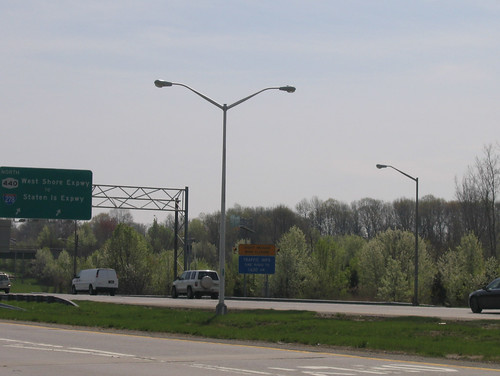 Callery pear (Pyrus calleryana) planted along Rt 440 in Staten Island.
Callery pear (Pyrus calleryana) planted along Rt 440 in Staten Island.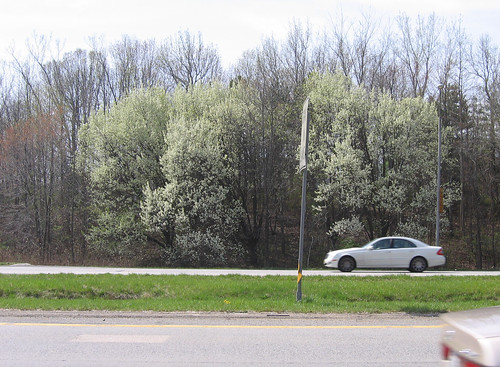 Callery pear (Pyrus calleryana) planted along Rt 440 in Staten Island.
Callery pear (Pyrus calleryana) planted along Rt 440 in Staten Island.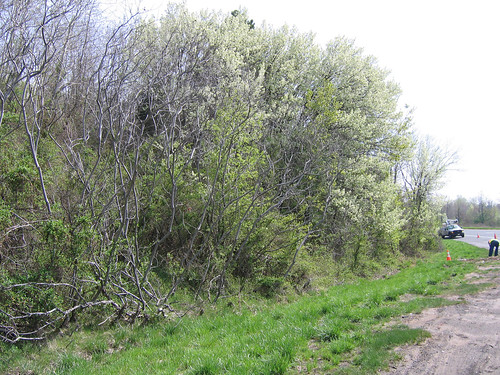 Callery pear (Pyrus calleryana) volunteering along Rt 440 in Staten Island.
Callery pear (Pyrus calleryana) volunteering along Rt 440 in Staten Island.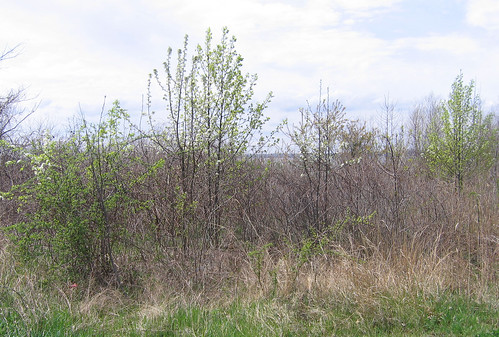 Callery pear (Pyrus calleryana) now found in Conference House Park. That was easy math.
Callery pear (Pyrus calleryana) now found in Conference House Park. That was easy math.
Posted by
drosera
at
10:38 PM
1 comments
![]()
Labels: invasive, NYC Parks, springtime, Staten Island, trees
Last year was my first time at Corson's Brook Woods, and it made a big impression on me - such a mecca of spring wildflowers! So, I visited again this year and it did not disappoint.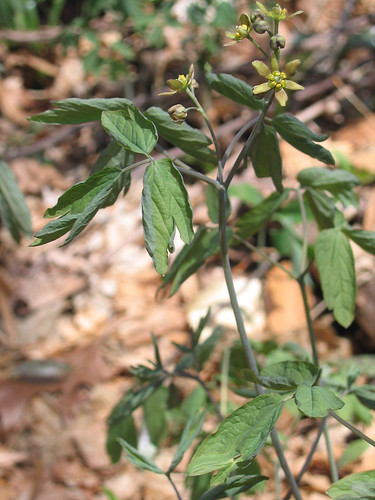 Blue cohosh (Caulophyllum thalictroides). A striking spring ephemeral, with its unusual flower color and greyish blue glaucous stem. Rare in NYC.
Blue cohosh (Caulophyllum thalictroides). A striking spring ephemeral, with its unusual flower color and greyish blue glaucous stem. Rare in NYC.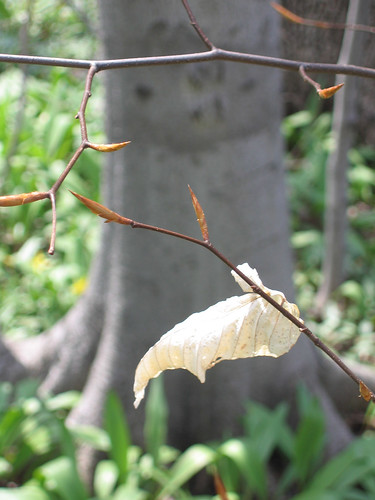 American beech (Fagus grandifolia). I don't know why, but beech trees hold onto their leaves all winter. They are a welcome splash of color in a winter woodland - and even in spring. Rich forest soils.
American beech (Fagus grandifolia). I don't know why, but beech trees hold onto their leaves all winter. They are a welcome splash of color in a winter woodland - and even in spring. Rich forest soils.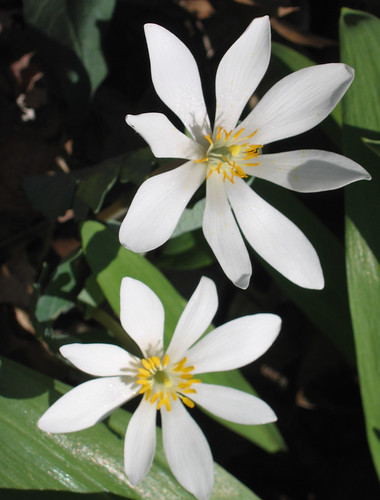
Bloodroot (Sanguinaria canadensis). Pure white. Lovely and fleeting. Rare in NYC.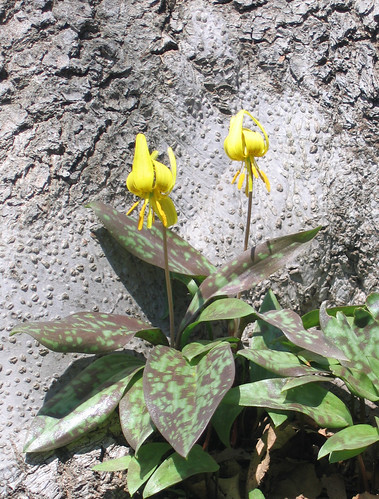 Trout lily (Erythronium americanum). An impressive amount, it just went on and on. These types of shade tolerant species are slow growing, and so such large colonies are very old - the population could've been many decades old.
Trout lily (Erythronium americanum). An impressive amount, it just went on and on. These types of shade tolerant species are slow growing, and so such large colonies are very old - the population could've been many decades old.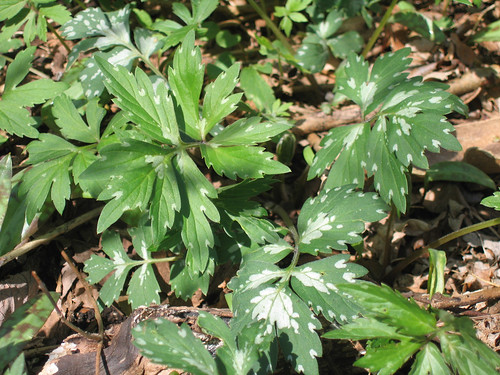
Virginia waterleaf (Hydrophyllum virginianum). Decorative foliage - the silvery spots that look like water stains. I'm surprised this isn't used more in the hort trade. It's a great groundcover. Found in rich forest soils and floodplains. Rare in NYC.
Posted by
drosera
at
10:06 PM
1 comments
![]()
Labels: ferns, forests, spring ephemerals, springtime, Staten Island, wildflowers

The Asian Longhorn Beetle has found its way to a natural area on Staten Island. ALB was first discovered in the US in street trees in Greenpoint, Brooklyn. The insect is thought to have arrived here from woody packing materials from China. ALB has proved to be persistent and able to spread from infestations when eradication has not been completed.
Now it looks like half the trees on the island will need to be cut down and chipped (which is how USDA treats this infestation). It should be interesting to see what comes back - on the Brunswick shale dreg island that is Pralls. Let's just hope this is the first and last natural area where we find these beetles.
Update:
Video of ALB on Pralls Island from the Staten Island Advance.
Posted by
drosera
at
6:18 PM
0
comments
![]()
Labels: exotic, insects, invasive, Staten Island
These pictures will make office workers everywhere weep with envy at how sweet it is to be a field biologist. Today I was working along Staten Island's South Shore. Fall foliage isn't limited to the trees. Here bracken fern (Pteridium aquilinum) glows a golden hue. {Most people think of ferns as dew-covered fronds growing lushly on the rich forest soils in the umbrage of canopy trees. Bracken fern laughs in the face of convention. It is a sunshine-embracing, sandy soil inhabiting fern. It is adapted to fire, with its root stock (rhizomes) nestled deep in the earth to avoid the flames. It's also quite common - keep an eye out for it the next time you are in the pine barrens or on Staten Island in Conference House Park or Clay Pit State Park Preserve.}
Fall foliage isn't limited to the trees. Here bracken fern (Pteridium aquilinum) glows a golden hue. {Most people think of ferns as dew-covered fronds growing lushly on the rich forest soils in the umbrage of canopy trees. Bracken fern laughs in the face of convention. It is a sunshine-embracing, sandy soil inhabiting fern. It is adapted to fire, with its root stock (rhizomes) nestled deep in the earth to avoid the flames. It's also quite common - keep an eye out for it the next time you are in the pine barrens or on Staten Island in Conference House Park or Clay Pit State Park Preserve.}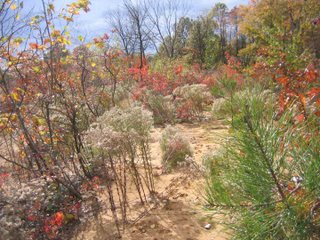 Here you can see clearly the glacial till sandy soils. The vegetation - trees - gray birch (Betula populifolia) and sassafras (Sassafras albidum) and that's a scrub oak to the right. The pine is short-leaf pine (Pinus echinatus). The shrubs are black chokeberry (Photinia melanocarpa) or if you are old school (Aronia melanocarpa) and the gorgeous reds in the background are highbush blueberry (Vaccinium corymbosum). The cloud-like white puffs are narrow-leaved boneset (Eupatorium hyssopifolium var. laciniatum), a New York State rare plant.
Here you can see clearly the glacial till sandy soils. The vegetation - trees - gray birch (Betula populifolia) and sassafras (Sassafras albidum) and that's a scrub oak to the right. The pine is short-leaf pine (Pinus echinatus). The shrubs are black chokeberry (Photinia melanocarpa) or if you are old school (Aronia melanocarpa) and the gorgeous reds in the background are highbush blueberry (Vaccinium corymbosum). The cloud-like white puffs are narrow-leaved boneset (Eupatorium hyssopifolium var. laciniatum), a New York State rare plant.
Posted by
drosera
at
7:51 PM
0
comments
![]()
Labels: autumn, field notes, forests, NYC Parks, Staten Island
 Poor Torrey's mountainmint (Pycnanthemum torrei). There has been so much hooey over this population (then scroll 4/5 down) of the globally rare plant. It used to be part of the gorgeous! pristine (in some sections)! rare plant inhabited! 130 acres Kreischer Hill parcel, which was owned by the NYC EDC.
Poor Torrey's mountainmint (Pycnanthemum torrei). There has been so much hooey over this population (then scroll 4/5 down) of the globally rare plant. It used to be part of the gorgeous! pristine (in some sections)! rare plant inhabited! 130 acres Kreischer Hill parcel, which was owned by the NYC EDC.
But conservation was not to be. Instead of thousands of years old glacial till sandy soils with their concomitant NYS rare communities and species, we have - what we've always needed! - Target, Home Depot, Bed/Bath/Beyond and a Christmas tree store. Hooray! That was certainly worth destroying the uncommonly occuring, sexually reproducing population of American chestnut. But that's just imho.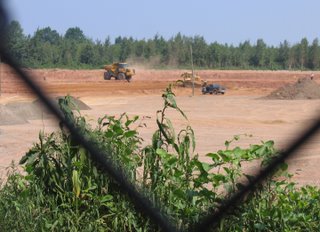
*Sigh*
Presently we are trying to conserve the population in situ (stop snickering!). This summer, we did a census of the mountainmint population. A transect was set up parallel to Veterans’ Road West. Every meter was marked off. Perpendicular to transect, 1m squared plots were set up. Within each plot the following data was collected – number of plants, number of individual stems, number of shoots, length of all stems, and the presence and number of flower heads. Casual observation suggests that the plants are grouped in clusters along this transect. This data will confirm whether or not this is the case. If so, further environmental factors will be examined to determine causal factors.
Posted by
drosera
at
7:56 PM
0
comments
![]()
Labels: field notes, rare, Staten Island, urban nature, wildflowers

Today I went out with my pal Ray to root around along Staten Island's south shore...won't say exactly where...and we found two orchid species new to City records – large coralroot (Corallorhiza maculata) and bog twayblade (Liparis loeselii). Large coralroot lacks greenery - it has tawny brown stems and no leaves. This is because it does not photosynthesize. It is saprophytic, meaning it feeds off organic matter, like fungi. It is added in its nutrient intake by a short, stubby, branched root that resembles coral. Small white, purple spotted flowers appear in late summer.
As the name suggests, bog twayblade is found in wetland, open habitats. It has unremarkable yellowish-green flowers that are only 1/4” long that bloom in late summer.
Posted by
drosera
at
7:38 PM
0
comments
![]()
Labels: autumn, field notes, forests, NYC Parks, rare, Staten Island, wildflowers

Clay Pit Pond in Staten Island
Had a most amazing day in Clay Pit State Park today - what a beautiful place. Very similar to NJ Pinelands (Barrens) except that we don't have the pitch pine (which is no small matter). There are individuals here and there, but actually pitch pine (Pinus rigida) is native and rare in NYC.
Ostensibly the trip was all about seeing swamp pink (Helonias bullata) - a Federally endangered plant, in flower. {N.B. I only throw out the location because I know these were PLANTED, which is fine since the species is historically known from this part of Staten Island. I would NEVER EVER reveal a naturally-occurring population - not for all the tea in China, not for all North Carolina.} The only native occurrence of Helonias bullata in New York was known from Kreischerville, Staten Island between 1882 and 1892 in a red maple-sweetgum swamp. In Arthur Hollick's field notes at the Staten Island Museum he noted that he and N. L. Britton did a “wild dance of joy” when they first encountered the plants in May 1882. See what the dancing was all about.
Sadly, dancing did not prevail the day I was out. We found the plants, but they are doing well; and so were not in flower (they only bloom when stressed). Oh well.

My disappointing view of swamp pink (Helonias bullata) - basal rosettes
Here is a list of some of the things we did see - all new for my records.KEY: * = exotic, ! = invasive, + = native & rare in NYC, no mark = native & common
TREES
Quercus alba - white oak
Q. bicolor - swamp white oak
Q. palustris - pin oak
Q. velutina - black oak
Quercus x bushii - a hybrid between Q. marilandica (blackjack oak) & Q. velutina
SHRUBS
Amelanchier canadensis - Juneberry
Chamaedaphne calyculata - leatherleaf +
Chimaphila maculata - spotted wintergreen
Comptonia peregrina - sweet fern +
Eleagnus angustifolia * - Russian olive
E. umbellata *! - autumn olive
Eubotrys racemosa - fetterbush
Lyonia ligustrina - maleberry +
Rubus phoenicolasius - wineberry *!
Salix discolor - pussy willow
Spiraea tomentosa - hardhack +
Vaccinium corymbosum - highbush blueberry
FORBS
Comandra umbellata bastard toad flax + (which might be the best common name for a plant ever)
Lepidium campestre * field pepper
Lespedeza capitata - round-headed bush clover
Linaria canadensis (Nuttallanthus canadensis) - blue toadflax
Symplocarpus foetidus - skunk cabbage
Viola macloskeyi ssp. pallens - smooth white violet
Posted by
drosera
at
9:02 PM
0
comments
![]()
Labels: field notes, forests, Staten Island, trees, wildflowers
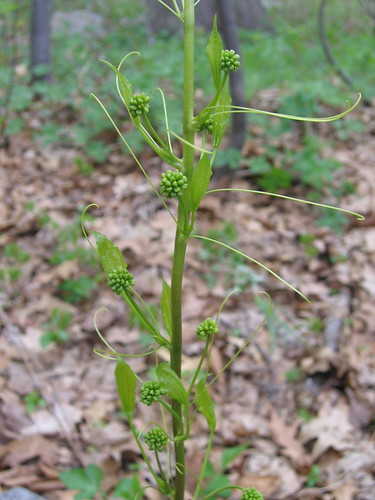
Downy carrionflower (Smilax pulverulenta) in bud. This vine is a New York State rare plant.
Meeting in SI Greenbelt this morning, walking along one of the trails, the first thing I see is the above downy carrionflower (Smilax pulverulenta), a NYS-rare vine. This is in the same genus as greenbrier & catbrier (S. rotundifolia, S. glauca), which are very common in the city, largely because they withstand disturbance so well. Downy carrionflower is herbaceous & perennial, so the whole above-ground portion of the plant dies back every winter. Here, it is bursting to bloom; looking a lot like pants' zippers after the wearer has enjoyed a particularly filling meal.
My concern was that the 3 plants I found were located along the trail, and one had already been stepped on. Imagine how resilient you would be sans lignin; not very. Hopefully my felled wood barriers will protect them another day.
Posted by
drosera
at
10:32 PM
0
comments
![]()
Labels: field notes, forests, Staten Island, wildflowers

Ups and downs, highs and lows, thus are my moods when I am out in the field - either ecstatic or crestfallen. Today, I was both. Somewhere in Staten Island (you'll never get locations out of me), I saw orchids, NYS-rare plants, and lots of degredation caused by humans.
First, the good stuff. In a 40' x 40' area, saw about 500 stems of whorled pogonia (Isotria verticillata), half of which were in flower. This orchid is a congener (same genus) as the Federally-endangered small whorled pogonia (I. medeoloides). These orchids were found in a dry, heath dominated forest they love so, with bracken fern, red/black/white oaks, red maple, sweet gum, sweet pepperbush, blueberries, pinkster azalea, black cherry, bitternut, and sassafras.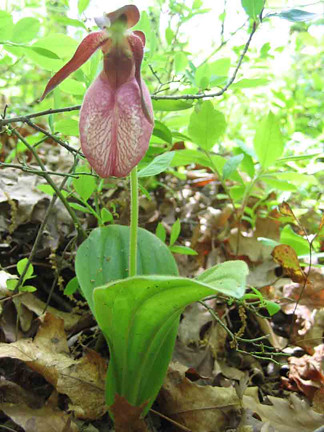
One of the most pilfered plants in the wild because it's arguably our most beautiful native orchid, pink ladyslipper (Cypripedium acaule).
Another wonderful site - pink ladyslipper (Cypripedium acaule) in bloom. Found some teasers early on - just leaves. The one in the photo was hiding behind a fallen log. In all we found 12 ladyslippers, but only 3 were in flower. Years ago, this area was called "Orchid Hill". I think the locals got wind of it and have been stealing orchids from the wild. Little do they know, that once these flowers are taken out of their natural habitat, they die. They cannot survive without filimentous fungi called microrrhizae, with which they have a mutualistic relationship. The fungi, extending into the orchid and the surrounding substrate, bring nutrients and water to the plant, and are critical in every phase of the plant's life. Orchid seeds are extremely small. As such, they have no resources to grow on their own. Without these fungi, the plants would never germinate.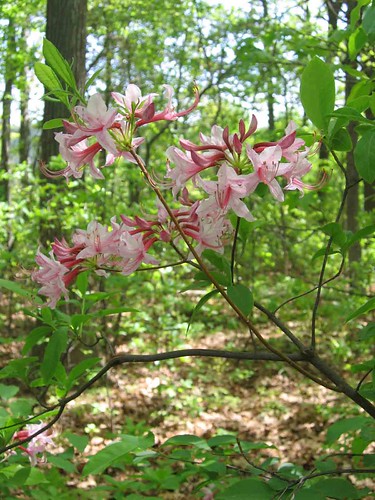
A common compatriot of these orchids, pinkster azalea (Rhododendron periclymenoides), a native shrub.
Other plant finds: whorled indian cukecumber (Medeola virginiana), deerberry (Vaccinium stamineum), red chokeberry (Aronia arbutifolia), black huckleberry (Gaylussacia baccata), interrupted fern (Osmunda claytonii), Virginia chain fern (Woodwardia virginica). Another neat find was sweetbay magnolia (Magnolia virginiana). This NYS-rare tree is found in wet areas, SI is the northern part of its range. Now, such plants, being rare, should be given some TLC. That was decidedly not the case in this park, as you can see in the photo below. (Warning, this is where the story starts to take a turn for the worse).
Here, the tree has clearly been vandalized, it has graffiti and a crown (base) damaged by fire. This is not a happy tree. Unhappy trees don't live very long, and so one less sweetbay in New York State.
Other areas of the forest are not regenerating due to disturbance. High volume foot traffic and mountainbike/ATV use contribute to the lack of shrubs or wildflowers in the photo below. And obviously, couches are not part of a forest ecosystem.
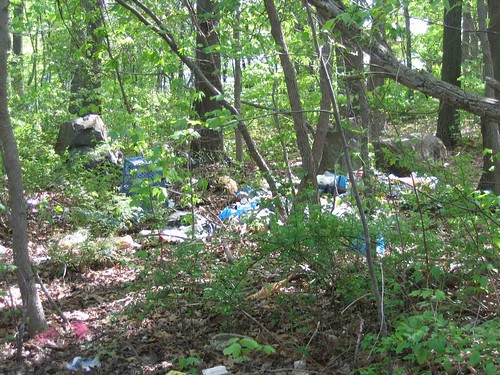
Posted by
drosera
at
10:07 PM
0
comments
![]()
Labels: field notes, forests, Staten Island, trees, wildflowers

To the tagger, this was totally unnecessary.
Posted by
drosera
at
8:16 PM
0
comments
![]()
Labels: field notes, NYC Parks, Staten Island, trees, urban nature

Today I went to Conference House Park, to look for a site to plant rescued plants from Kreischerville up the road. These "rescued" plants are listed as rare in New York State - blunt spikerush (Eleocharis ovata) (S1) & fringed boneset (Eupatorium hyssopifolium var. laciniatum) (S2), which is the reason why we went to so much trouble to dig some up - otherwise they'd be sitting under the Home Depot, Target, Bed Bath Beyond, Chilis & Christmas tree store that was put there in its place. God knows we need more strip malls, especially sharing a very long border with a state nature preserve (Clay Pit).
Anyway, on my way to Conference House Park, I stopped by an area we refer to as "Rare Oak Woods" because it houses, wait for it, rare oaks. Onsite there are willow oaks (Quercus phellos), an S1, that are hybridizing with more common oaks (black, red). These hybrids can be prodigious producers of acorns, and subsequent generations often results in pure willow oak offspring. A super rare oak is the hybrid Q. x rudkinii, a cross between willow oak and blackjack oak (Q. marilandica), another rarity. Mostly these plants are rare in NY because they are at the northern part of their range. This also means that without all the hybridization, it would be difficult for them to reproduce. Ah, oaks. For more on NYS rare plants
Rare Oak Woods has very sandy, glacial outwash soils, as does this whole area of southern SI. This makes for really neat plant communities, with lots of heath shrubs. I love the heaths. Most people think of Heathcliff & Catherine ala Charlotte Bronte (writing out "Heathcliff" made me think of that Michael Penn song, "No Myth". I really like that song. Whatever happened to him anyway?); but the northeast has lots of native woody plants in this family (Ericaceae).
Highbush blueberry (Vaccinium corymbosum) in flower, with a Lepidopteran visitor. Another common native shrub.
Yet another interesting plant was pawpaw (Asimina triloba), another rarity (S2). This tree isn't actually native to NYC, it naturally occurs in western New York State, but there is a colony in Staten Island, planted by a former homeowner in the 1800s with seed from Indiana. The grove produces flowers (see below) and fruits. The latter are edible, reputed to resemble bananas both in taste and aspect. Haven't tried any yet, but hopefully this summer I will remember to make a trip down there.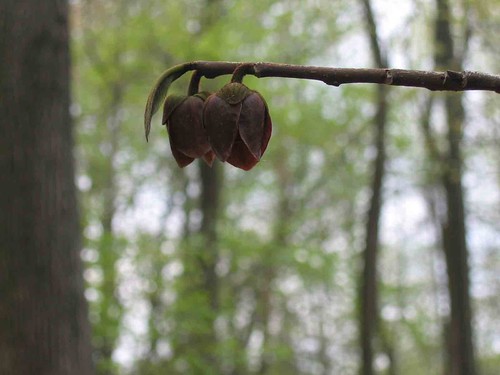
Posted by
drosera
at
11:51 PM
0
comments
![]()
Labels: field notes, forests, rare, shrubs, springtime, Staten Island, trees, wildflowers